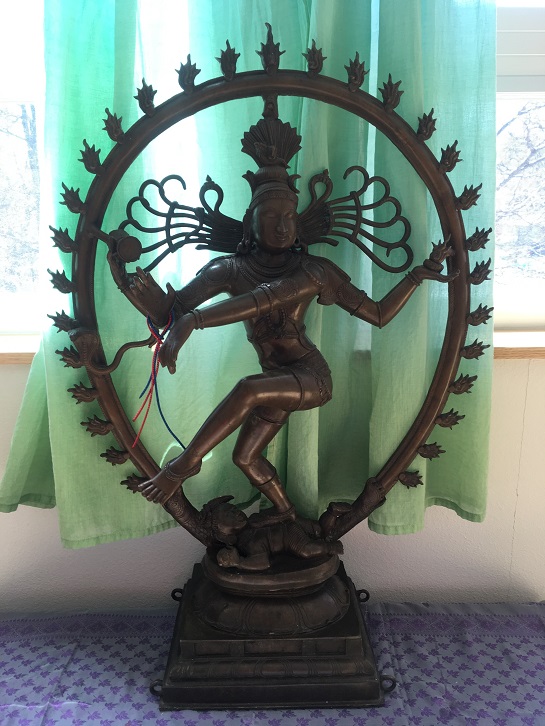The image of Naṭarāja, Śiva as the Lord of Dance, encapsulates many beautiful teachings. To begin, take a moment to pause and consider your impression of Naṭarāja (there is an image below).
– For a few moments take in the feel of Naṭarāja —not so much the specific details, but the overall presence of the image and how it resonates with you.
– Write about your general sense of this image.
Whatever you see is what you see, but one of the main things the image elicits is, of course, a dance. Naṭarāja is dancing, but there is also a sense of serenity. His face is serene; he is very steady and aligned along a central axis. Yet this is a wild dance, and Naṭarāja’s hair is flying about. So here there is a representation of both the wild dance and a serene center.
One way to think of these qualities relates to the meaning of Śiva as the ground of being, the unmanifest, quiet and centered, stillness itself. But also in the image of Naṭarāja, Śiva is dancing the world into manifestation. From the center of his dance, everything begins to pulsate, and all of manifestation occurs. He’s starting the whole wheel turning, from which all that is manifest is created. So there is an aspect of Śiva as the cosmic dancer dancing life itself into existence.
These two aspects of Naṭarāja are related to a thread that runs throughout yoga philosophy and is mirrored in the modern yoga scene: the contrast and choice between what are termed nivṛtti and pravṛtti paths of yoga. The term vṛtti relates to turning or revolving. Nivṛtti is turning away from the world. This path requires renouncing the world and all associated desires. Pravṛtti is turning toward the world. This path involves engaging in the world. So there is a general contrast between two paths of yoga: the nivṛtti, or renunciate path, and pravṛtti, the householder path.
When I first began my yoga journey, the perceived push toward asceticism in the yoga world was very confusing to me. I began my practice in a very rigorous yoga school that emphasized breath, a steady gaze, and a prescribed sequence of postures. It required immense discipline, focus, and dedication. Through that practice, I got a glimpse of the quiet mind, a still point, that part of me that was watching, the draṣṭṛ/seer, that serene center reflected in Naṭarāja’s face and centeredness.
I began to have larger questions about the path of yoga and started exploring the philosophy underlying the practice. At that time, there weren’t many texts or books on yoga, but one that was available was the Yoga Sūtra, which delineates an ascetic or renunciate path, turning awareness inward and away from the world. I began to understand how such a philosophy could lead to a strict and controlled approach toward the body and mind, which was what I was experiencing in my āsana practice. I was so perplexed by this perspective, which didn’t resonate with me. Again and again, I found myself asking, If the goal of yoga is to subjugate the body and withdraw the mind from the world, why are we born into these bodies, into this world, with the gift of such active minds?
When I encountered a different yoga āsana school that honored the body, mind, and all of manifestation as part of a divine pulsation, it drew me in. It resonated with what I sensed intuitively. I found out that this approach was based on Tantric yoga philosophy, a development that came later than the Classical Yoga of Patañjali’s Yoga Sūtra. And Tantra acknowledges a householder path for those who choose to function in society and all that entails.
I felt lucky to have experienced both of these schools, and it felt that each had a piece of the truth, yet I struggled to reconcile them. This is the paradox represented in Naṭarāja, the serenely quiet yogi and the wild dancer. Eventually I realized what was missing from these schools of yoga āsana was the practice of meditation. In both, there was a sense that one should be meditating, but no method was explicitly integrated. So when I saw the opportunity to begin practicing and studying a Tantric-based meditation method, I dove right in.
Along with receiving a meditation practice for householders, I learned how the practice worked, which allowed me to assimilate my previous experiences. I came full circle back to the teachings of Patañjali’s Yoga Sūtra with its emphasis on meditation and practice. And as I began studying Tantra, I confirmed that there was more than the ascetic path, as I’d always intuited. The meditative state is not the end but the beginning. Through meditation, we connect to the ground of being, which supports us as we then move through everyday householder activities.
Patañjali’s Yoga Sūtra tells us the ultimate limb of yoga is samādhi, that state of enstatic, or internal, awareness. But Tantra represents a path that leads to more stages of yoga beyond samādhi. These further stages allow one to live a fully embodied life from a place of expanded awareness. One can experience the Divine while embodying the householder life. In this way, Yoga and meditation can be a support in the many dances in life.
Reflect and Explore
How do you see the relationship between practices that move you inwardly and living your life fully as a householder?
Have you experienced any conflict regarding these two paths of nivṛtti/inward turning/renunciate and pravṛtti/outward turning/householder?
How have you experienced yoga practice supporting householder life?



